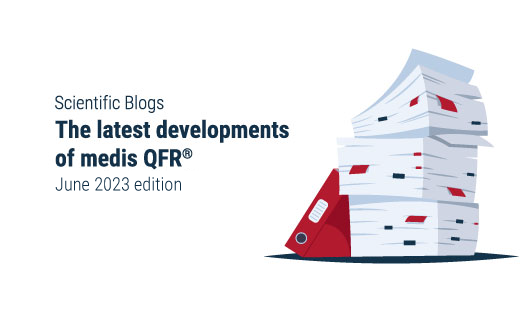Education
The latest developments of Medis QFR®
December 2023 edition
7 mins – December 8, 2023 – Written by Prof. Hans Reiber
We are delighted to present to you our latest Medis QFR® blog. By keeping you informed about the advancements and benefits of Medis QFR® in this rapidly evolving field, we strive to support your decision-making process and contribute to improved patient outcomes. Whether it’s the evaluation of lesion significance, personalized treatment decisions, or reducing adverse events, we aim to cover a broad range of topics related to Medis QFR® ‘s application and efficacy. This innovative and angio-based solution for coronary physiology has gained significant recognition and is extensively utilized in clinical research and practice globally. Discover five key publications that highlight the latest developments in Medis QFR® and join us in revolutionizing coronary physiology assessment. Keep informed, enhance patient care.
In this new Medis QFR® blog, we are proud to share five publications on the latest developments of Medis QFR with you.

Angiography-based assessment of coronary microvascular function: First US report of IMRangio
Dr. E.T. Ha and co-authors from the Division of Cardiology, New York Presbyterian Brooklyn Methodist hospital under the senior authorship of Dr. Y. Kobayashi, published this first US report on the QFR-IMR. The authors provide two case report of patients with angina, who were referred to the cath lab and underwent additional coronary microvascular dysfunction (CMD) assessment with both wire-based IMR and the Medis IMRangio. One case had a negative IMR that was confirmed by IMRangio, and the second one a positive IMR, also confirmed by IMRangio. The authors envision a further streamlined workflow in the cath lab, where a simultaneous assessment of epicardial and microvascular disease is carried out solely from coronary angiography.

Quantitative Flow Ratio is feasible and accurate even at lower frame acquisition rate
Dr. A. Milzi and co-authors from the Dept of Internal Medicine, University Hospital of the RWTH Aachen in Germany published this Research Letter in Circulation Cardiovascular Interventions. This is a retrospective study in 457 vessels from 351 patients undergoing coronary angiography at a 10 fps acquisition rate and FFR. Mean difference between FFR and QFR was 0.014 and a high linear correlation (0.763). The sensitivity was found to be 74.7%, specificity 93.3% and AuC=0.932. This high feasibility and diagnostic accuracy was reached without optimized projections, due to the retrospective nature of the study. The authors concluded that QFR is feasible and accurate at lower image acquisition rates of 10 fps, which reduces radiation exposure, without relevantly influencing the diagnostic yield.


Comparison among various physiology and angiography-guided strategies for deferring percutaneous coronary intervention: a network meta-analysis
Dr. Y. Kiyohara from the University of Tokyo hospital, Japan and co-authors under the supervision of Dr. T. Kuno from the Albert Einstein College of Medicine in NY, USA published this interesting paper in Cardiovascular Revascularization Medicine. They carried out an evaluation on the clinical efficacy of various PCI strategies through a network meta-analysis of randomized controlled trials (RCTs). The strategies were FFR, iFR, QFR and coronary angiography(CA)-guided approach. Their search identified 12 eligible RCTs including a total of 13.177 patients. They found that QFR was associated with reduced MACE, myocardial infarction (MI) and target lesion revascularization (TLR) compared with CA, and ranked the best in most outcomes. In the subgroup analysis of the ACS cohort, there were no significant differences in MACE between any comparisons.

Current status and future perspectives of fractional flow reserve derived from invasive coronary angiography
Dr. M. Dobric and co-authors under the supervision of Dr. M. Bojic, from the University of Belgrade in Serbia published this interesting paper in Frontiers in Cardiovascular Medicine. In this paper the authors present an overview of the currently available data on angio-based solutions for coronary physiology, a critical review of the major clinical trials, and further directions of development for the five most widely available non-invasive indices: QFR, vFFR, FFRangio, caFFR, and AccuFFRangio.

Effects of percutaneous coronary intervention and diabetes mellitus on short- and long-term prognosis assessed by the three-vessel quantitative flow ratio
Dr. Y. Chen and co-authors from the Dept of Cardiology, Fujian Medical University in China published this paper in Diabetes Research and Clinical Practice under the supervision of Dr. Y. Luo. In this retrospective study a total of 2440 vessels from 1181 patients, who underwent PCI were analyzed. The patients were categorized according to the presence or absence of diabetes mellitus (DM) and the median of the 3 V-QFR (from the QFR of the main vessels, the 3 vessel QFR (3 V-QFR) was calculated). They found that over the course of 2 years of FU, the incidence of MACE was higher in both groups with a post-PCI 3V-QFR < 2.94. From 2-5 years, patients with DM had higher rates of MACE. The authors concluded therefore that in the short-term, a low post-PCI 3V-QFR is a predictor of high risk for MACE, but in the long run , DM emerges as the dominant factor.
Share this article on:
Related articles

The latest developments of Medis QFR®
October 2023 edition

The latest developments of Medis QFR®
July 2023 edition

The latest developments of Medis QFR®
June 2023 edition
